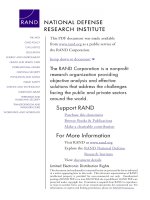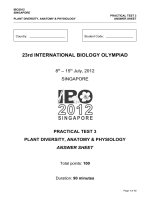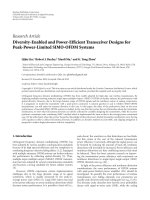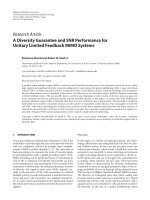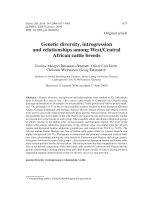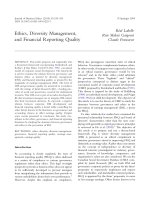Insect diversity, taxonomy, and systematics ( PDFDrive )
Bạn đang xem bản rút gọn của tài liệu. Xem và tải ngay bản đầy đủ của tài liệu tại đây (13.1 MB, 178 trang )
Protura, Collembola, Diplura
6-segmented
abdomen; furca and
retinaculum;
collophore on A1
/>
Isotomidae
Sminthuridae
Archaeognatha and Zygentoma
arched trunk; 3 terminal filaments;
dorsally contiguous eyes; styli on A1-9;
monocondylic mouthparts
flattened; 3 terminal filaments; eyes
reduced or absent; dicondylic mouthparts
Long narrow wings (4); slender, elongate abdomen,
large compound eyes, short bristle-like antennae, cerci
unsegmented and function as claspers.
Zygoptera: front and hind
wings similar in shape and
narrow at base
Coenagrionidae
Cu1 + Cu2 well developed
(well beyond arculus)
Anisoptera
hindwings wider at base
Libellulidae: toe well
developed on anal loop; no
notch on rear wing anal angle
Zygoptera
Odonata:
Libellulidae
Coenagrionidae
Short filiform or setaceous
antennae; mesothorax enlarged
with large triangular
forewings; hindwings small or
absent; A10 with long cerci
and often with medial filament
Ephemeroptera
Order: Zoraptera “Pure-wingless”
Characters:
• 39 species worldwide, mostly tropical
•3 mm or less in length
•Short cerci and antennae
•small colonies beneath rotting wood
•detritivores and predators (on Collembola and mites)
Dermaptera
short elytra meeting dorsally in a straight line;
cerci well-developed and forceps-like;
antennae filliform and about ½ length of body
or less
Plecoptera: elongate; flattened; FW
long and narrow, HW shorter with
large anal lobe; wings with many
veins; tarsi 3-segmented; cerci
present and often long; usually
3ocelli
Orthoptera
large hind femora; leathery wings
Caelifera: diurnal jumping orthoptera; tympana on A1; short
antennae and ovipositer; tarsi 3 or fewer.
Tetrigidae: pronotum extends over
abdomen and is narrowed posteriorly
Acrididae
Ensifera: nocturnal jumping orthoptera; tympana on front tibiae;
long antennae; stridulate with wings; long ovipositor
Gryllacrididae
Gryllotalpidae
Tettigoniidae: long-horned grasshoppers and
katydids; most tarsi 4-segemented; ovipositor
flattened
Stenopelmatidae
Gryllidae: crickets; 3-segmented tarsi; ovipositor reduced
Order: Mantophasmatodea
• 1st described in 2001 from 30 my amber
• 20 - 30mm
• One family and 3 genera
• Predaceous
• found in S. Africa; exhibit high endemism (~41 sp)
Order:
Grylloblattodea
• 25 spp
• Discovered in 1914
• 15-30 mm
• Live in extreme
environments
Order: Embioptera “lively wings”
• 500 species, mostly tropical and subtropical
•Superficially resemble Plecoptera
• Produce silk from cellular glands on anterior basal tarsus
• Spend life in spun silken galleries in litter, soil, rocks, etc
• One introduced species in NA is Parthenogenic
• Adult males do not eat
Order: Phasmatodea
• 3000 spp
• Slow moving herbivorous
• 2000 species worldwide
• Widely distributed, but richest in the tropics
Mantodea
Blattodea
body flattened and oval; head
concealed by pronotum; antennae
long and slender
Isoptera
usually pale colored; antennae
short and often moniliform;
with and without wings—held
flat over abdomen at rest; tarsi
4-segmented
Thysanoptera
minute (.5-2mm); pale to black; with and without wings—long and
narrow, fringed with long hairs; sucking mouthparts (conical beak)
Heteroptera
Hemiptera
Sternorrhynhcha
Beak rises from between procoxae
Auchenorrhyncha
Beak rises from anterior part of head
Beak short, rises posteiorly
Hemiptera –
Heteroptera
Auchenorrhynca
Sternorrhynca
